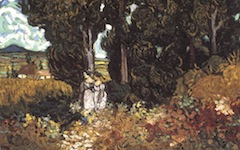Van Gogh’s On the Road to Tarascon (1888)

Van Gogh, On the Road to Tarascon (July 1888) Oil on canvas. Stolen by Nazis; destroyed.
Click image to enlarge.
This unusual self-portrait by Van Gogh depicts him, as he himself wrote, "laden with boxes, props, and canvas on the sunny road to Tarascon” in southern France.1 Everyone who seeks self-knowledge like Van Gogh must take a journey through life following the wisdom of past sages, religious or secular. There are many ways but all together are known as The Way. Indeed the story of a spiritual journey, as in Homer's Odysseus, Chaucer's Canterbury Tales or Dante's Commedia, is one of the few basic plots in literature.
Click next thumbnail to continue

Top: Van Gogh, On the Road to Tarascon (July 1888)
Middle: Courbet, Bonjour Monsieur Courbet (1854)
Bottom: Gauguin, Bonjour Monsieur Gauguin (1889)
Click image to enlarge.
Thirty years earlier Courbet had painted himself on a journey meeting his patron, widely acknowledged as a scene about art (center). In 1889, a year or less after Van Gogh's example, his friend Gauguin openly reimagined Courbet's scene with a similarly-titled painting (bottom). They are worth comparing to the Van Gogh. A distinctive feature of Van Gogh's composition (top) is that his shadow with a long leg seems more dynamic than his own figure. His stick, a natural visual analogue for his paintbrush, points to the shadow and thus "paints" it. Shadows, again as in literature, often symbolize the dark side of the soul as the inner, sometimes chaotic, source of creativity. However, when contrasted with light, the two together can potentially, and additionally, convey the duality of man's physical existence versus the unity of the spirit.
Courbet (middle) emphasized his shadow too while Gauguin (bottom) may have represented his "shadow" in the mysterious, dark figure he meets, their postures a reflection of one another. If so, the latter's "shadow", which faces the canvas as painters do, is "painting" his own self-portrait on the other side of a gate composed of wooden struts like those supporting a canvas.
In EPPH's paradigm of art, a shadow being painted by an artist or his alter ego seems to convey on the universal level that we all paint - or create - our own demons. If, on the other hand as in the Gauguin, the shadow paints the artist, this appears to suggest that our public identities and self-images (like Gauguin's self-portrait) are all constructed from within. We imagine who we are and then become it.
Click next thumbnail to continue

Top L: Giacometti's Self-portrait with a Brush (1918)
Top R: Munch, Old Man Praying (1902)
Lower L: Hals, Portrait of Jean de la Chambre (c.1634)
Lower R: Beckmann, Self-portrait with Sculpture (1941)
Click image to enlarge.
Painting shadows is a common, little-known scene in art. We have shown before how Giacometti (top L) draws his own shadow in an early self-portrait and how Edvard Munch's Old Man Praying (top R) does so on the cloth he faces. Also on EPPH is a portrait by Frans Hals (lower L) of a writer who paints his own shadow. And in Max Beckmann's self-portrait (lower R) he seems to sculpt a shadow too.
Click next thumbnail to continue
Van Gogh's focus on creative imagination in this painting is further emphasized by the inaccurate color of his eyes: bright green blanks. Green, of course, is the color of fertility (here, mental) and as he walks along the path of life carrying his own tools, his figure suggests that we all "paint" our own lives and that to live a better, happier one, we need the right tools and the creativity to imagine it. Imagination itself is a tool which helps explain why art's meaning is so heavily focused on artists painting themselves. We can all turn ourselves into a masterpiece.
More Works by Van Gogh
See how a portrait viewed one way resembles a portrait; viewed another way turns the world inside out

Van Gogh’s The Zouave (1888)
Notes:
1. Van Gogh, Letter to Theo van Gogh from Arles (14th August 1888). Trans. Johanna van Gogh-Bonger, ed. Robert Harrison, number 524. Retrieved online Sept.15th 2015, from http://webexhibits.org/vangogh/letter/18/524.htm
Original Publication Date on EPPH: 22 Jan 2016. © Simon Abrahams. Articles on this site are the copyright of Simon Abrahams. To use copyrighted material in print or other media for purposes beyond 'fair use', you must obtain permission from the copyright owner. Websites may link to this page without permission (please do) but may not reproduce the material on their own site without crediting Simon Abrahams and EPPH.



